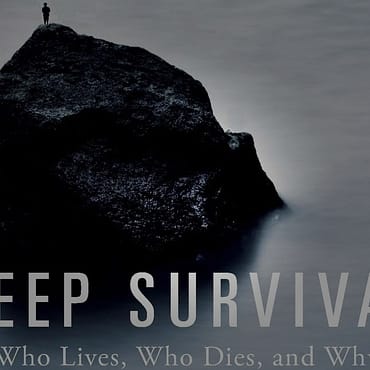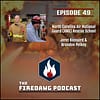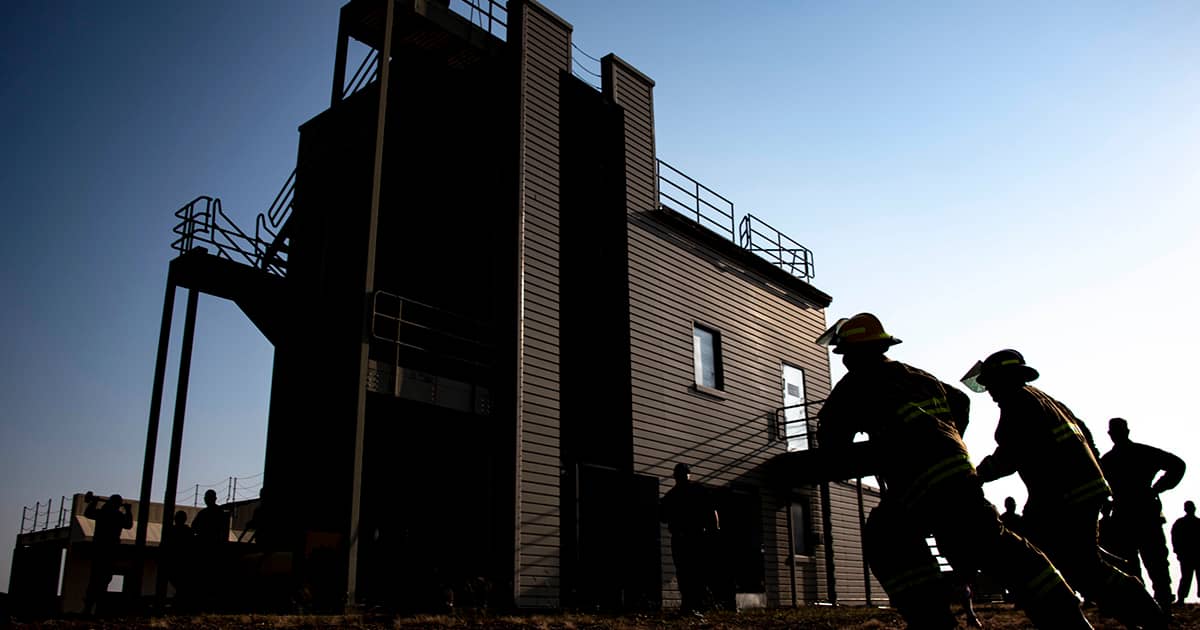
Deep Survival: Who Lives, Who Dies, and Why
Laurence Gonzales, author of Deep Survival, believes there is a very discoverable science behind the book’s subtitle: Who Lives, Who Dies, and Why. Through his story telling ability and real-life […]
 play_arrow
play_arrowTable Talk – 06 – Engine Company Decision Making and the Rule of 3s – Austin Perry FireDawg.us
 play_arrow
play_arrowEpisode 49 – North Carolina Air National Guard (ANG) Rescue School FireDawg.us
 play_arrow
play_arrow play_arrow
play_arrowTable Talk – 04 – A Standardized Approach to Fireground Size Up – Brandon Laird FireDawg.us
 play_arrow
play_arrowEpisode 48 – After Action Review – Firefighter Rescue & Survival (FRAS) Class 9 – Ryan Julius & Leah Lloyd FireDawg.us

Metaphors are often used to relate principles of a story or lesson by placing them in a different context, providing a visualization of the principles. I am a visual learner, and so the use of metaphors is a tool I like to use when training or educating others in hopes that they may understand the topic as I do.
Leading in a fire department can be simultaneously challenging and rewarding. Developing tens to hundreds of individuals into effective teams is not something most can do successfully without having a model to follow. There are countless excellent fire department leaders who I wouldn’t dare put myself in the same class with by sharing an unproven model as though it is gospel, but I do believe that if it may be of help to even one aspiring leader out there then it is worth putting out there.

Imagine a three-legged stool. The shape of the three legs connected to the seat gives it a triangular-pyramid design that has been used to build some of the world’s strongest structures. Now, if you take away one of those legs, the entire structure topples to the ground. That is the schema I would like to use for this leadership model, in hopes to convey the importance of each of the components towards the strength of the whole.
In terms of leadership, we will use the stool to represent an outcome (the seat), and the inputs that support that outcome (the legs). Each leg has certain characteristics that give it shape and strength, both in relation to itself, the other legs, and the stool as a whole. Let’s now examine each component of the stool representing effective fire department leadership.
Atop the stool is the reason for its very existence, to provide a place for one to sit. That may sound simplistic, but it is exactly the solution for the need. The desired outcome of effective fire department leadership is delivering high-quality fire protection services, positive patient/victim outcomes, and well-developed teams and individuals within the department. That is why we exist, at a base level. If that is our reason for existing and is exactly the solution for the duty in which we have been charged, then all of our efforts (inputs) should be driven towards supporting that desired outcome.
At the core of our duty is to provide firefighting services to the public in support of life safety, incident stabilization, and property conservation. The services we provide are, of course, much more robust; emergency medical response, hazardous materials, technical rescue, and more. It is our duty to train hard, be physically fit, and know what we are doing.
More than meeting the standard, we must be driven. Be hungry for more reps, more drills, and more chances to train. Be thirsty for education expanding your tactical, operational, and strategic knowledge. Chase opportunities to do more than you are paid for, knowing that at the end of the day you are not there simply for the paycheck. Being a driven professional means knowing that you have more to learn, do, and teach.
This leg of the stool provides the elements of technical competence, continuous improvement, and motivation. Those elements alone would take any fire department to a place where they think they may be good, or even the best. However, as you will see when we continue with the other two legs, these characteristics will only be strengthened and multiplied when combined with the others. What is more, is that a department that only has this without the other two may be fooling themselves into a false sense of security that they have it all together. That might make them susceptible to blind spots, unintended consequences, and flat-out failure.
Being associated with or being a part of the military, you surely know the phrase Good Order and Discipline. It is a key tenet of doctrine by which the armed forces have always operated and is actually included in the Uniform Code of Military Justice. When an organization fails, it usually fails for one of three reasons: lack of pride, lack of performance, or lack of professionalism. Unfortunately, leaders have rarely been able to mandate pride successfully. Weak leaders lean on performance mandates to leverage compliance. The best leaders mandate professionalism.
Dress and appearance standards may seem like a small matter only there to check a box, but what do the failings of these standards signal? It says to your customer that you aren’t worried about the details. It says that you don’t take pride in your job. It says that you feel it is appropriate to bend or break the rules, or worse that they don’t apply to you. While shined shoes or appropriate station-wear isn’t going to make you a better firefighter, it very likely reflects the caliber of firefighter you are.
Customs and courtesies is another area that gets a bad rap. I’ve always been told, “you never shake a man’s hand sitting down.” I couldn’t agree more, but unfortunately, I may be in the minority opinion when it comes to paying respect. Some have probably heard the expression, “respect is earned, not given.” I would challenge you to examine yourself, your morals and values, and see if that should be the case. In my opinion, respect should be given freely, and only the lack of it earned. Junior members should stand while being spoken to by a senior member. Senior members would do well to give the appropriate respect and attention to junior members, if only simply as a signal that “that is how we do it here.” One cannot expect a lack of any respect to blossom into respect given in return.
“What you tolerate is what you will get, and that becomes your culture.”
Harvey Goldberg
Culture is multifaceted. In some respect, it is like wallpaper; you see it as soon as you walk into the room. In other ways, it is subtle, hard to pinpoint, and harder to change. What is the culture in your department? Is it one that permits gossip, cliques, and unhealthy dissent, or is it one that expects honest effort, clear expectations, and accountability?
This second leg is perhaps not one that everyone may consider to be equal in importance to the fire department. I suggest that in relation to the fire department’s effective operations on and off the fireground, the day-to-day culture of the organization is of utmost importance to invest in.
We have all heard the fire service be referred to as a “brotherhood.” In this sense, brotherhood is all-inclusive regardless of gender or any other factors. This fraternal bond is a critical element to the success of firefighters, past and present. So, what then happens when that bond erodes over time into nothing more than an empty phrase?
Dining together is always a good place to start. If a group of firefighters can’t bond over food, then we may have more serious issues to address. With almost no exception, I cannot think of a single good reason for any firefighter to eat a meal alone while at work. If you were on a call and missed lunch, then your whole rig probably did too. Sit down and break bread.
While many places may have the food thing figured out, it’s about much more than this. When was the last time your peer held you accountable for something you did or didn’t do? Do you take time to mentor the probie while washing the dishes after dinner? Have you gone on your day off to mow your brother’s yard for his pregnant wife while he’s deployed on a wildland taskforce? This is brotherhood. You spend considerable time at work with your fire-family, maybe even more than your home-family. You should invest in the relationships, developing the bonds between you and your brothers.
Morale is often cited as a concern for departments. Many times, the problem with morale is purported to lie with the department’s leadership. I would argue that if the firefighters working operations together can’t sit and eat with one another, don’t take time to take the probie under their wing, and care for each other’s families – then there is nothing the Chief can do to help you. That part is on you.
This third and final leg has strong relationships with the other two. Firefighting is, and will always be, a team sport. You must build your team’s strengths and work on its weaknesses before you get to the fire. You must have trust with one another, knowing that the firefighters in the fight with you are technically, emotionally, physically, and spiritually ready to do the job. On the other hand, what is a team without discipline? Discipline in yourself to do the right thing even when no one is looking, and discipline as a team to work on the hard things, do one more rep, and not quit until you can’t get it wrong.
This stool is simple. The outcome of an effective fire department depends on driven and disciplined firefighters and the strong bond between them. Each leg is equal in its importance, providing a stable foundation for the department to sit on. Take one leg out, or even shorten it by ignoring the regular maintenance on it, and you could see your department tumble to the ground in an instant.
Tagged as: mentorship, leadership, chief, development, growth.

Chris Bauchle January 10, 2021
Laurence Gonzales, author of Deep Survival, believes there is a very discoverable science behind the book’s subtitle: Who Lives, Who Dies, and Why. Through his story telling ability and real-life […]
FireDawg.us © 2020-2022 // Any link on this website may be linked to an affiliate, such as Amazon // DOD Disclaimer: The views and opinions presented by any member or administrator of this site are those of the individual(s) and do not necessarily represent the views and opinions of the Department of Defense or the United States Air Force. No government endorsement is implied for any link or content within this site.
Post comments (0)